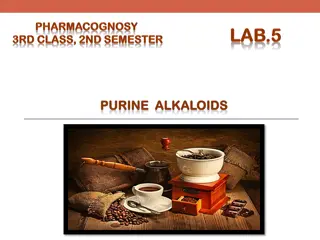Understanding Caffeine Extraction from Tea Leaves
Caffeine, a widely consumed alkaloid, is extracted from tea leaves using organic chemistry techniques. This process involves liquid-liquid extraction to isolate the caffeine from the mixture of substances. The efficiency of extraction relies on the solubility of the target compound in a chosen solvent, meeting specific requirements for successful isolation. Through the use of partition coefficients, the quantification of the extraction process aids in determining the amount of compound extracted in each step.
- Caffeine Extraction
- Organic Chemistry
- Liquid-Liquid Extraction
- Solvent Selection
- Partition Coefficient
Download Presentation

Please find below an Image/Link to download the presentation.
The content on the website is provided AS IS for your information and personal use only. It may not be sold, licensed, or shared on other websites without obtaining consent from the author. Download presentation by click this link. If you encounter any issues during the download, it is possible that the publisher has removed the file from their server.
E N D
Presentation Transcript
Lecture 3a Extraction of Caffeine from Tea Leaves
Caffeine - Background Caffeine is a naturally occurring alkaloid that belongs to a class of compounds called xanthines. It is found in varying quantities in the seeds, leaves, and fruits of some plants. It is the world s most widely consumed psychoactive drug. In humans, caffeine acts as a central nervous system stimulant, temporarily warding off drowsiness and restoring alertness. It acts as a natural pesticide that paralyzes and kills certain insects feeding on the plants, as well as enhancing the reward memory of pollinators. Caffeine was first isolated by F. Runge in 1819 from coffee as Kaffebase . H. E. Fischer first synthesized caffeine in 1895. Reference: http://www.caffeineinformer.com/ Drink mg/fl oz Coffee Brewed 20 Tea (black) 5.2 Tea (green) 3.1 Expresso 51 Coca-Cola 2.8 Red Bull 9.5 5 Hour Energy, Rockstar 100
Caffeine - Metabolism Caffeine (1,3,7-trimethylpurine-2,6-dione) is metabolized in the liver by cytochrome P450 oxidase, which causes a demethylation in different positions: File:Caffeine metabolites.svg Principal alkaloid in cocoa bean
Extraction I Extraction is a very commonly used technique in organic chemistry, which involves the selective isolation of products from mixtures of substances. The most common type of extraction in chemistry is liquid- liquid extraction that is often based on acid-base chemistry to change the solubility of the compound. The solute is extracted from one solvent into the other because the solute is (usually) more soluble in the second solvent than in the first. It is one way to facilitate the isolation of the target compound: Extraction: aims at the target compound Washing: removes impurities from the organic layer
Extraction II If an organic compound is extracted from an aqueous layer or a solid, the chosen solvent has to meet certain requirements for an efficient extraction: The target compound should dissolve very well in the solvent at room temperature ( like dissolves like rule applies) a large difference in solubility leads to a large value for the partition coefficient (also called distribution coefficient), which is important for an efficient extraction. The solvent should not or only slightly be miscible with aqueous phase to be extracted. The solvent should have a low or moderately low boiling point for easy removal at a later stage of the product isolation.
Distribution Coefficient I The extraction process can be quantified using the partition coefficient K (also called distribution coefficient): C solubility of solute in solvent 2 = 2= K C solubility of solute in solvent 1 1 Using this partition coefficient, one could determine how much of the compound is extracted in each extraction or after n extractions: n ( ) Final mass of solute V + water ) 2 V = ( Initial mass of solute V K water 2 1 K = Partition coefficient or distribution coefficient V1 = Volume of the organic layer in each extraction V2 = Original volume of water n = number of extractions Wo = Initial mass of solute
Distribution Coefficient II The larger the K-value, the more efficient the extraction 50 50 49 49 48 48 47 47 46 46 K= 10 Wo= 50 mg V1= 1.5mL V2= 1.0 mL Wo=50 mg V1=1.5 mL V2=1.0 mL K=3 Series3 45 45 Series4 Series1 44 44 Series1 43 43 42 42 41 41 40 40 1 2 3 4 5 6 7 8 9 10 1 2 3 4 5 6 7 8 9 10 For K=10, two extractions are sufficient to extract about 99.6 %. For K=3, four extractions are required to accomplish the same degree of the extraction.
Distribution Coefficient III Partition coefficients are defined in different solvent systems i.e., log Kow, also called log P, which quantifies the distribution of a compound between octanol and water. ??????= log(???????? ??????) A negative value implies that the compound is polar and dissolves better in water than in octanol. Compound Log Kow 1.90 Water solubility at 20 oC Benzoic acid Poorly (3 g/L) Sodium benzoate -2.27 Highly (556 g/L) Phenol 1.46 Soluble (83 g/L) Sodium phenolate -1.17 Highly (530 g/L) Triethylamine 1.45 Soluble (130 g/L) Triethylammonium chloride -1.26 Highly (1370 g/L) Log Kow-values are used to characterize the polarity of organic compounds like drugs i.e., caffeine (-0.07), acetaminophen (0.27), lidocaine (2.44), ibuprofen (3.79).
Solvent Choice Solubility issue (water=W, solvent=S) Solvent Log Kow 1.97 S in W W in S Flammable Density Chloroform 1.5 0.8 % 0.056 % NO 1.48 g/cm3 Dichloromethane 8.9 1.25 1.3 % 0.25 % NO 1.33 g/cm3 Diethyl ether 4.3 0.89 6.9 % 1.4 % YES 0.71 g/cm3 Ethyl acetate 6.1 0.73 8.1 % 3.0 % YES 0.90 g/cm3 Hexane 1.9 3.90 ~0 % ~0 % YES 0.66 g/cm3 1-Propanol 20.8 0.25 YES 0.80 g/cm3 Acetone 21.0 -0.24 YES 0.79 g/cm3 The higher the dielectric constant ( ) of a compound (solvent) is the more soluble it is in water according to the like-dissolves-like rule. The miscibility of solvents can be reduced by changing the polarity of the liquid phase.
Salting Out The addition of a salt increases the polarity of the aqueous layer: It causes a decreased solubility of many organic compounds that are usually lower in polarity. It forces the organic compound into the organic layer, thus increases the partition coefficient. A solid will precipitate out while a liquid will become immiscible. The addition of a lower polarity solvent to an aqueous layer will reduce the overall polarity of the solution: It causes polar compounds like salts to precipitate from solution. The solubility of sodium chloride in water will decrease if the ethanol is added to the solution.
Green Tea Extract Below is the HPLC of a Green Tea Extract [M + H]+ (m/z) Concentration mg/ml Peak Rt(min) Compound 1 3.77 335 Galloylquinic acid 6.18 2 4.17 171 Gallic acid 0.59 3 6.66 307 Gallocatechin 4.5 4 9.13 307 Epigallocatechin 7.13 5 10.60 340 Dicaffeic acid 0.32 6 11.09 291 Catechin 1.59 7 12.08 195 Caffeine 19.16 8 16.02 291 Epicatechin 3.34 9 17.26 459 Epigallocatechingalate 53.18 10 26.42 304 Ellagic acid 0.82 Column: C18-column Flow rate: 0.5 mL/min Mobile Phase: Gradient of 1 % formic acid in water (A) and acetonitrile (B) (A gradient run was started at 90 % gradient A, decreasing in 30 min to 75 %, further decreasing to 10 % in 5 min and then back to 90 % in 10 min) 11 27.91 443 Catechingallate 3.29 12 29.45 466 Quercetin glucoside 0.35
Caffeine Solubility The solubility of caffeine differs greatly from solvent to solvent: Solvent Temperature g/L Water 25 21 80 200 100 666 Ethanol 25 15 78 32 Acetone 30 22 Diethyl ether 25 1.9 The solubility of caffeine changes a lot in water, being poor in cold water and very high at high temperatures. The solubility is poorer in most organic solvents (i.e., ethanol, acetone, diethyl ether). The addition of sodium chloride decreases the solubility by a factor 1.5 pro molarity of sodium chloride. The addition of sodium sulfate would decrease the solubility of caffeine significantly more but it cannot be used because calcium ions are added afterwards leading to the formation of CaSO4.
Tannic Acid Tannic acid is very soluble in water (2850 g/L). Why? The presence of tannins in the bark of redwood (Sequoia) is a strong natural defense against wildfire, decomposition and infestation by certain insects such as termites. It is found in the seeds, bark, cones and heartwood. The commercial tannic acid is a decagalloyl glucose.
Important Points The caffeine is separated from the rest of the tea ingredients by several extraction steps. The first step is a solid-liquid extraction using hot water ( brewing ). In the liquid-liquid extraction, the aqueous layer that has been saturated with sodium chloride is extracted with propanol: Normally, propanol-water mixtures are completely miscible. Propanol-salt water mixtures are poorly miscible with the organic layer containing a large amount of water (~20 %). The addition of the sodium chloride increases the polarity of the aqueous later, which reduces the solubility of the caffeine and 1-propanol in the aqueous layer. Caffeine is better soluble in propanol than in the salt water solution resulting is a larger distribution coefficient (K=3.7).
Procedure I Place two bags in hot water Allow the solution to cool down What is the purpose? Extraction of all the water-soluble components of the tea (peptides, sugars, tannins, pigments) Add solid sodium chloride to the solution Why is sodium chloride added? It increases the polarity of the solution but keeps the caffeine in solution Add solid Ca(OH)2 Why is calcium hydroxide added? It causes the tannic acid and other colored impurities to precipitate as calcium salts What is the best way of doing this? The liquid is decanted first before the solid is transferred into the funnel Remove the precipitate by vacuum filtration
Procedure II Extract the caffeine into 1-propanol Separate the two layers using a separatory funnel Add anhydrous sodium sulfate to organic layer Which layer contains the caffeine? The organic layer=top layer What is the student looking for here? 1. Some free flowing drying agent 2. A transparent solution How is accomplished? By decanting or using a pipette to transfer the solution Remove the anhydrous sodium sulfate Why is this step necessary? To recover some of the absorbed product Wash the solid with a small amount of 1-propanol Why is the drying agent removed? 1. The drying process is reversible 2. The product and the drying agents are both white solids which makes it impossible to separate them later!
Procedure III Place the solution in a beaker of appropriate size on the hot plate, add a boiling stick and evaporate the propanol carefully Why is a boiling stick added here? To allow for a smoother boiling without bumping Careful: Propanol is flammable! Caffeine will dissolve in acetone while any sodium chloride will remain undissolved Add acetone to remaining solid Remove the liquid (E1) Repeat the extraction step (E2) Remove the solvent from the combined organic layers (E1+E2) like before The dry product is collected and stored in a closed vial The sublimation of the product is skipped Careful: Acetone is flammable!























